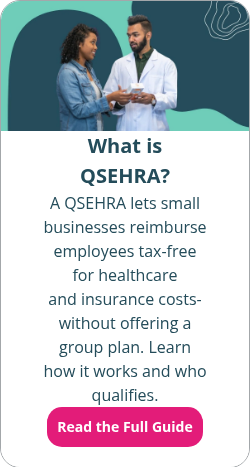Offering a QSEHRA vs. group health insurance
By Elizabeth Walker on October 9, 2024 at 8:00 AM
The traditional healthcare benefits option for employers remains group health insurance. But, group policies are difficult for small employers to offer. That’s why more small business owners are turning to more cost-effective personalized benefits like the qualified small employer health reimbursement arrangement (QSEHRA).
The introduction of the QSEHRA in 2016 gave small business owners access to an affordable and flexible health benefit. As an alternative to a group health plan, the QSEHRA has grown popular among employers. But if you’re unsure which option is best for your organization, you may want to compare the two employee benefits first.
This guide will explain the differences between the QSEHRA and group health insurance. We’ll also compare the two health benefits in a comprehensive chart.
In this blog post, you’ll learn:
- The critical differences between QSEHRA and group health insurance.
- The financial implications of each benefit type.
- The ease of administration associated with QSEHRA compared to group health plans.
What is a QSEHRA?
First, let’s briefly review how a QSEHRA works. A QSEHRA is for employers with fewer than 50 full-time equivalent employees (FTEs) who don't offer a group health or ancillary plan. With this type of HRA, small employers can reimburse employees tax-free for their individual health insurance premiums and other qualified out-of-pocket medical costs.
With a QSEHRA, you set a monthly allowance for your employees. This is the most you’ll spend on reimbursements for monthly premiums and other medical care expenses. Once employees make an approved purchase, you reimburse them tax-free up to their set allowance amount.
HRAs are employer-owned, so only you can fund them. The QSEHRA has no minimum contribution requirements. But, the IRS sets annual maximum contribution limits. Because of its flexibility, the QSEHRA is an excellent solution for small businesses looking for a quality health benefit that won’t blow their budget.
What is group health insurance?
Next, we’ll discuss group health insurance. A group health plan is an insurance policy employers buy and offer their employees. Employees can enroll in this type of plan at a reduced rate because insurers spread risk across the entire group. Individuals can’t buy group coverage on their own—it’s only available to a group.
Most employers offer a major medical group plan, such as a health maintenance organization (HMO) policy, preferred provider organization (PPO) plan, or another type of policy.
Employers can buy a group plan from a health insurance company, licensed agent, or broker. In some states, smaller employers can buy a small group plan on the Small Business Health Options (SHOP) marketplace.
Group health insurance covers 153 million Americans. Because most individuals are familiar with how it works, it continues to be a popular health benefit for employers of all sizes.
How does a QSEHRA compare to group health insurance?
Choosing the right health benefit can go a long way toward attracting and retaining key employees in a competitive job market. So before you decide between offering the QSEHRA or group health insurance at your company, let’s go into detail about how they compare.
Eligibility
In most states, employers with 1-50 employees can buy small group health insurance on the SHOP Marketplace. The SHOP Marketplace helps small employers provide secure, affordable health coverage. But there are eligibility requirements.
Below are the eligibility rules small employers must follow to buy a SHOP plan1:
- SHOP plans are for employers with 1-50 FTEs. In some states, employers can have up to 100 FTEs.
- If you have only one FTE, it must be someone other than the owner. It also can't be the owner’s spouse, another family member, or a business partner.
- Typically, small employers must enroll at least 70% of workers in the group plan. Minimum participation requirements can be challenging for small organizations to meet.
- The organization can't offer coverage if it doesn’t meet the minimum requirements.
- SHOP plans waive minimum participation requirements if you enroll from November 15 to December 15.
- If you’re shopping on a state-based SHOP exchange, you must have a physical office within that state.
- You must offer coverage to all your full-time employees, which is anyone who works 30 or more hours per week.
Employers ineligible for a SHOP plan can enroll in traditional group health coverage directly from a private insurance company as long as they meet the participation requirements and can afford the premiums.
To avoid the eligibility requirements that come with group health plans, small employers can offer a QSEHRA.
The following are the eligibility requirements for QSEHRAs:
- A QSEHRA is only for employers with fewer than 50 FTEs. Employers can’t offer group health insurance or an ancillary plan.
- If you have 50 or more FTEs, you can still offer an HRA. An individual coverage HRA (ICHRA) is available to employers of all sizes.
- As long as you have at least one W-2 employee, you can offer a QSEHRA.
- You must offer the QSEHRA on equal terms to all your W-2 full-time employees.
- You can offer it to your part-time workers on the same terms as full-time employees.
- Employees must have a health plan that provides minimum essential coverage (MEC) to participate.
Flexibility
Group plans have limited flexibility, especially if you have a diverse workforce.
Here are some potential flexibility concerns that come with group plans:
- The one-size-fits-all structure of group coverage can leave your employees with limited healthcare options depending on their needs and location.
- Each state has its own minimum participation requirements and other insurance regulations. Depending on how many locations your company has, finding a group plan that works for every employee can be tricky.
- Your chosen insurance company may only operate in some states or counties. If you have remote workers who live across the U.S., they may not all be able to get coverage. You may have to offer multiple health plans.
- Some insurance providers offer multi-state group health plans. But even if your insurer offers one, your employees’ network providers and covered medical services will vary. This can provide a negative employee experience and reduce company morale.
- Employers choose the group plan that works best for their organization. This means employees don’t have a say in their plan options or covered services.
- For example, your plan may not cover their preferred healthcare provider or medical services. This can result in your staff paying more out-of-pocket medical expenses.
If you want to offer a flexible benefit, a QSEHRA is the better choice. You can customize it and support your employees—regardless of their specific needs.
Here’s a snapshot of how a flexible QSEHRA can work for your organization:
- With a QSEHRA, employees can choose the individual coverage that works best for them. They can use the benefit as long as their health plan provides MEC. This means employees with coverage through their spouse or parent can still participate.
- Employers can determine whether they want only premiums or premiums plus qualified out-of-pocket costs to be eligible for reimbursement.
- Our 2024 QSHERA Report found that 42% of all QSEHRA reimbursements were for health insurance premiums. But 58% were for non-premium medical expenses. So, offering a premium plus QSEHRA is the most valuable option for employees if you have the budget.
- You can design your QSEHRA to allow employer-sponsored premium reimbursements (ESPR). This allows you to reimburse your employees for their spouse’s employer-provided health plan premiums. These reimbursements will likely be taxable.
- If your company is fully remote, you can still reimburse your employees for their individual health plan premiums. This allows them to choose the best plan for themselves, their families, and their geographic location.
- You can vary QSEHRA allowance amounts by family status, age, and family size.
- Unlike group health insurance, QSEHRAs have no minimum participation requirements.
Cost
Group health insurance is sometimes less expensive for employees than other coverage options. This is because the risk spreads among the entire group and because their employer contributes toward the cost of their premium. But it’s generally still a costly option for small employers because they have a smaller group.
Let’s look at the general cost of group health insurance below:
- In 2023, the average annual group health insurance premium was $8,435 for self-only coverage and $23,968 for family plans2.
- Employers contributed an average of $7,034 toward their employees’ self-only coverage and $17,393 toward family coverage.
- Employers who qualify for the small business health care tax credit can save on premium costs for SHOP plans.
- Eligible employers who qualify for the tax credit can receive up to a 50% discount on their employees' premiums. Nonprofit employers can receive up to 35% off.
- Group plan premiums vary by age, number of participating employees, your company’s medical claim history, industry, and other factors.
- Most group policies have annual rate hikes. So, it can be difficult for employers to predict their costs from year to year.
In contrast, QSEHRAs don’t require employers to buy a group plan. So, they’ll save on premiums and avoid rising healthcare costs.
Here’s a look at how cost works with a QSEHRA:
- QSEHRAs have no minimum contribution limits. You can offer an allowance that works best for your organization if you have a smaller budget. This gives you greater control over your company finances.
- You can offer up to the set annual maximum if you have a larger budget. In 2026, small businesses can contribute up to $6,450 for self-only employees and $13,100 for employees with a family. Once you set your allowance, employees can’t exceed it.
- These allowance caps are less than the average cost of employer contributions to a group plan. This shows that even by offering the full allowance, employers can save money compared to a group plan.
- You don’t pre-fund HRAs. Instead, you only reimburse employees after they buy an eligible expense and you approve their claim documentation. Any unused allowance at the plan year's end (or if an employee leaves your company) stays with you.
- All QSEHRA reimbursements are free of payroll taxes for employers and employees. Reimbursements are also free of income tax for your staff.
- If you use HRA administration software or a third-party administrator (TPA), you’ll have to pay a monthly or annual fee for their services. Depending on your chosen TPA or HRA administrator, your costs will vary.
Premium tax credits
Employees who have employer-sponsored group coverage are usually ineligible to receive premium tax credits. That’s because credits are only available to individuals who have unaffordable coverage. Most times, traditional group plans meet the ACA affordability requirements so employees can’t qualify for credits.
However, on the rare chance that an employee has unaffordable group coverage, they may be able to qualify for premium tax credits.
Check out how employees with unaffordable group plans can leverage premium tax credits in the section below:
- Employees with group health coverage are only eligible for tax credits if their premiums are unaffordable.
- Before, affordability testing for group plans only used the employee’s income and the cost of a self-only plan. Now, the calculations use household income and the cost to cover the employee and their eligible family members.
- If an employee’s plan is unaffordable (meaning they pay more than 9.02% of their income for coverage), they can decline it and buy subsidized marketplace coverage if they qualify for premium tax credits.
- If employees accept their employer’s plan, their family members can still decline it and buy subsidized ACA coverage.
HRA allowances pay for monthly health insurance premiums with tax-free money. Therefore, eligible employees must coordinate their QSEHRA allowance with tax credits. Similar to group health plans, this depends on affordability.
Let’s see how employees must coordinate their QSEHRA with tax credits:
- For 2025, an employee’s QSEHRA allowance is affordable if they’re not paying more than 9.02% of their actual income for the second-lowest-cost silver plan premium on the Marketplace.
- They’ll run these affordability calculations after they factor in your QSEHRA allowance.
- If an employee’s QSEHRA is affordable for a given month, they can’t collect their credits that month. If your benefit isn’t affordable for one or more months and they’re eligible for credits, they can collect them. But they must reduce their subsidy by their QSEHRA allowance.
Ease of administration
Even though many employers offer group health insurance, it can be time-consuming and complex to administer. This is especially true for small employers with limited resources and budgets.
Learn what you need to know about administering a group health plan below:
- You must frequently communicate with your health insurance company and employees to manage your group plan effectively. This ensures your enrollment process runs smoothly and your staff knows what to expect from their health plan coverage.
- A benefits specialist can help you manage your employees’ health insurance questions. But, this may not be workable if you have a small HR team.
- The annual benefit renewal process for group health insurance plans is complex. You must review your benefits package, survey your employees, research policy options, work with insurers, negotiate premium rates, conduct an effective enrollment process, and potentially more.
- These tasks are time-consuming and can take time and money away from running other aspects of your business.
You must manage a QSEHRA properly to avoid compliance issues and deliver the most value for your employees. You can self-administer a QSEHRA. But, using an HRA administrator, like PeopleKeep, is easier for small employers. Plus, it will save you time and help reduce errors.
Here’s how PeopleKeep can help you manage your QSEHRA benefit:
- Administering your QSEHRA with PeopleKeep is quick and headache-free. Most small employers can administer their benefit in only a few minutes per month.
- We tackle tedious tasks, such as:
- Preparing and updating plan descriptions
- Reviewing reimbursements
- Storing employee documentation
- Following compliance regulations
- Staying current on industry trends
- Your employees can shop for health insurance right from their PeopleKeep accounts, simplifying the process of finding coverage.
- You and your employees will have access to our award-winning customer support team. You can contact our team if you have questions about administration, reimbursing employees, IRS regulations, what expenses are eligible, and more.
- Unlike working with a TPA, our software is only a support system for you for plan design and beyond. That way, you remain in control of your benefit the entire time.
QSEHRA vs. group health insurance comparison chart
The chart below recaps the key differences between the QSEHRA and group health insurance.
|
QSEHRA |
Group health insurance |
|
|
What is it? |
With a QSEHRA, small employers can reimburse eligible employees tax-free for their individual health plan premiums and other qualified medical expenses. |
A traditional group health plan is an insurance policy employers buy and offer their employees. Employees split a portion of their premium costs with their employers. |
|
Employer eligibility requirements |
The QSEHRA is for employers with fewer than 50 FTEs that don’t offer a group health or ancillary plan. Employers must have at least one full-time W-2 employee. |
In most states, employers with 1-50 employees can buy a small group health insurance plan through the SHOP Marketplace or their state-based exchange. |
|
Employee eligibility |
All full-time W-2 employees are automatically eligible for the benefit. Employers can also invite part-time workers to join. Employees must have a health plan with MEC to participate. |
Employers must offer a SHOP small group plan to all their full-time employees. They can choose to include part-time workers as well. |
|
Annual allowance caps |
The 2026 maximum employer contribution limits are $6,450 for self-only employees and $13,100 for those with a family. Employers can vary allowances by family status, age, and family size. |
N/A |
|
Flexibility |
Employees with a QSEHRA can choose their own individual health insurance policy. Additionally, employers can choose their preferred eligible expenses for reimbursement and support remote workers regardless of location. |
Employees usually only have the choice of one group policy. Employers must also meet strict participation requirements. |
|
What is the average employer cost? |
The cost of the QSEHRA varies depending on your chosen allowance amount. If you administer your benefit with a TPA or HRA software, you may also have annual service fees. However, employers only pay employees for medical care after they approve an eligible expense. |
Group plan premiums generally vary depending on the percentage of the premium the employer covers, plan type, location, employees’ ages, and other factors. However, group plans generally have rate hikes yearly, which can be too costly for small business owners. |
|
Tax credit guidelines |
Employees with a QSEHRA can collect their premium tax credits if their allowance is unaffordable. But, the amount of their QSEHRA allowance will reduce their premium tax credit. |
Employers who enroll in a plan through the SHOP Marketplace may qualify for the small business health care tax credit. Employees may be eligible for premium tax credits if their group health plan is unaffordable. |
|
Administrative burden |
HRA administration software like PeopleKeep can save you from managing the most time-consuming tasks. These tasks include preparing and updating legal documents, reviewing reimbursements, tracking compliance regulation changes, and more. You and your employees can access our customer support team if you have questions or need help. |
Group health insurance plans require constant communication between the employer, health insurance company, and employees. You’ll also have to manage complex annual benefit renewals, review plan changes, negotiate premium costs, and research new policies. These responsibilities can be challenging for small employers with limited HR teams. |
Conclusion
While many large employers still offer group health insurance, it may not be the best choice for small business owners. Group plans are costly, rigid, and time-consuming to administer. Plus, they may not meet your diverse staff’s unique needs. Instead, a QSEHRA is an attractive alternative to group health plans that gives your employees greater control over their healthcare outcomes while saving your company money.
If you’re a small business owner looking to offer a QSEHRA, PeopleKeep has what you need. With our HRA administration software, we’ll help you manage your QSEHRA benefit quickly and easily so you can spend your valuable time running your business. Have a conversation with one of our HRA specialists today, and we’ll get you started!
Check out more resources
See these related articles

What can an HRA reimburse?
Wondering if your HRA can cover specific medical costs? Discover the comprehensive list of eligible expenses that your HRA can reimburse in this article.

What is healthcare reimbursement?
Looking to reimburse your employees for their healthcare expenses? Learn everything you need to know about healthcare reimbursement.

What is the family glitch, and is it fixed?
Curious about the Family Glitch and its impact on your healthcare coverage? Find out everything you need to know.



